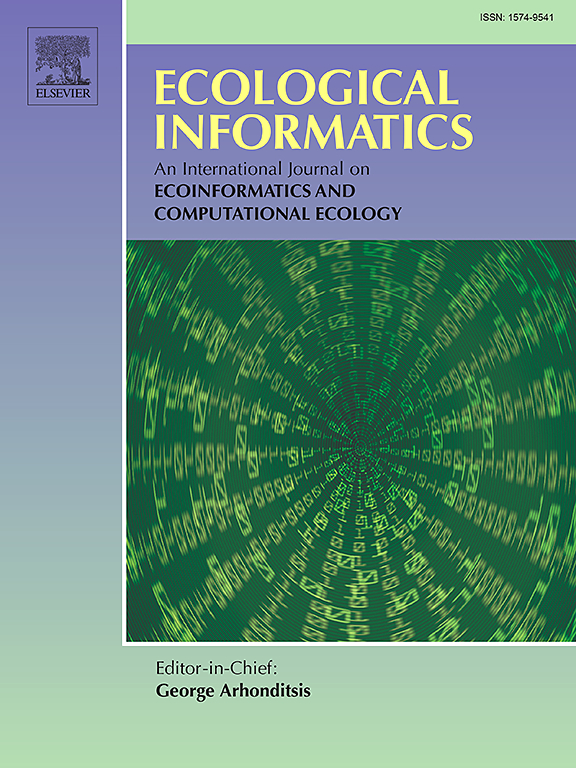对比太平洋和大西洋沿岸生态系统中浮游动物指标成像系统的效率
IF 7.3
2区 环境科学与生态学
Q1 ECOLOGY
引用次数: 0
摘要
中浮游动物在海洋食物网中起着关键作用,将初级生产者与更高营养水平的生产者联系起来。它们的丰度和特征是生态系统结构和功能的关键指标,是长期海洋监测的重要组成部分。然而,监测生物多样性和功能特征及其明显的时空变异性需要大量采样,并且存在重大的实验室瓶颈和与成本相关的挑战。成像仪器与自动图像分类器(如Ecotaxa)相结合,提供了一种有前途的解决方案,可以实现高通量、经济高效地处理大量样本,同时还提供了以前用传统方法无法实现的高精度特征测量。在这项研究中,我们比较了人类分类显微镜、人类分类图像和计算机分类图像在加拿大太平洋和大西洋沿岸三个不同的沿海生态系统中的表现。首先,我们证明了在识别大量图像方面的前期投资有助于健壮的区域图像库的发展,这大大提高了自动分类器的性能(例如,平均F1分数= 0.54,每个分类单元多达200张图像,每个分类单元多达5000张图像)。结果表明,自动图像分类性能随标本的对称性、测地线厚度和类群丰富度等特征而变化。然后,我们评估了每种方法如何捕获当地浮游动物多样性和改变关键生态指标。基于观察到的生态系统特异性差异,我们提出了优化与本地多样性模式相关的分类工作流程的建议。本研究提供了大规模的经验证据,表明投资开发区域图像库可以提高沿海生态评估的可扩展性和准确性。这些新兴的数字资产具有显著推进生态系统监测和管理的潜力。本文章由计算机程序翻译,如有差异,请以英文原文为准。
Contrasting the efficiency of imaging systems for mesozooplankton indicators across Pacific and Atlantic coastal ecosystems
Mesozooplankton have a pivotal role in marine food webs, linking primary producers to higher trophic levels. Their abundance and traits serve as key indicators of ecosystem structure and function, making them essential components of long-term ocean monitoring. However, the need to monitor biodiversity and functional traits, combined with their pronounced spatial and temporal variability, requires extensive sampling and presents significant laboratory bottlenecks and cost-related challenges. Imaging instruments, combined with automated image classifiers such as Ecotaxa, offer a promising solution by enabling high-throughput, cost-effective processing of large numbers of samples, while also providing highly precise trait measurements previously unattainable with traditional methods. In this study, we compare the performance of human-sorted microscopy, human-sorted images and computer-sorted images across three contrasting coastal ecosystems on Canada's Pacific and Atlantic coasts. First, we demonstrated that upfront investment in identifying a larger number of images contributed to the development of robust regional image libraries, which significantly enhanced the performance of automated classifiers (e.g., mean F1 score = 0.54 with up to 200 images per taxon and 0.68 with up to 5000 images per taxon). Results showed that automated image classification performance varies with specimen characteristics such as symmetry, geodesic thickness, and taxa richness. We then assessed how each method captures local mesozooplankton diversity and altered key ecological indicators. Based on observed ecosystem-specific differences, we provide recommendations for optimizing classification workflows in relation to local diversity patterns. This study provides large-scale empirical evidence that investing in the development of regional image libraries enhances the scalability and accuracy of coastal ecological assessments. These emerging digital assets have the potential to significantly advance ecosystem monitoring and management.
求助全文
通过发布文献求助,成功后即可免费获取论文全文。
去求助
来源期刊

Ecological Informatics
环境科学-生态学
CiteScore
8.30
自引率
11.80%
发文量
346
审稿时长
46 days
期刊介绍:
The journal Ecological Informatics is devoted to the publication of high quality, peer-reviewed articles on all aspects of computational ecology, data science and biogeography. The scope of the journal takes into account the data-intensive nature of ecology, the growing capacity of information technology to access, harness and leverage complex data as well as the critical need for informing sustainable management in view of global environmental and climate change.
The nature of the journal is interdisciplinary at the crossover between ecology and informatics. It focuses on novel concepts and techniques for image- and genome-based monitoring and interpretation, sensor- and multimedia-based data acquisition, internet-based data archiving and sharing, data assimilation, modelling and prediction of ecological data.
 求助内容:
求助内容: 应助结果提醒方式:
应助结果提醒方式:


